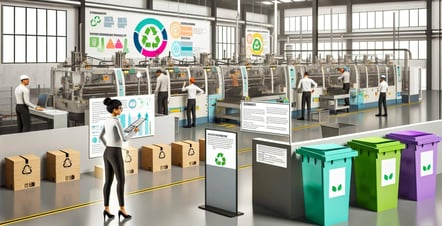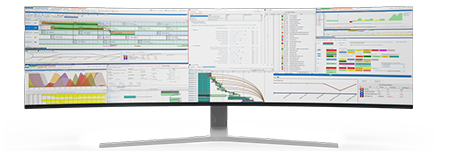Topics: PlanetTogether Software, What-If Analysis, Integrating PlanetTogether, Real-Time Data Exchange, Real-Time Visibility into Production Processes, Real-Time Communication, Finite Capacity Planning, Real-time Responsiveness to Changes
In the landscape of industrial manufacturing, sustainability has become a critical factor influencing decision-making processes across various sectors. For metalworking facilities, the need to adopt environmentally friendly practices is more pressing than ever.
In this blog post, we will look into the realm of sustainable production planning specifically tailored for the green metalworking industry. As a Production Scheduler, you play a pivotal role in ensuring efficient operations, and we'll explore how integrating advanced planning tools, such as PlanetTogether, with leading ERP, SCM, and MES systems like SAP, Oracle, Microsoft, Kinaxis, and Aveva can amplify the positive impact of sustainable practices.
Sustainable production planning involves optimizing manufacturing processes to minimize environmental impact, conserve resources, and reduce carbon footprint. In green metalworking, this translates to a commitment to eco-friendly practices throughout the entire production lifecycle, from raw material procurement to final product delivery.

Resource Optimization: Efficiently utilizing resources, including raw materials, energy, and water, is fundamental to sustainable production planning. Production schedulers need to prioritize processes that minimize waste and maximize resource efficiency.
Renewable Energy Integration: Incorporating renewable energy sources into manufacturing operations is a key element of green metalworking. By scheduling production during periods of peak renewable energy availability, facilities can reduce reliance on non-renewable sources and contribute to a lower carbon footprint.
Waste Reduction Strategies: Implementing strategies to reduce, reuse, and recycle waste is crucial for sustainable metalworking. Schedulers must align production schedules with waste reduction goals, ensuring that the facility operates with minimal environmental impact.
Supply Chain Sustainability: Collaboration with suppliers who share the commitment to sustainable practices is essential. Integrating sustainability criteria into supplier selection and scheduling processes helps create a more responsible and eco-friendly supply chain.
Lifecycle Assessment: Conducting a comprehensive lifecycle assessment of products aids in identifying areas where improvements can be made. This assessment should cover the entire value chain, from raw material extraction to end-of-life disposal.
![]()

To achieve a seamless and sustainable production planning process, integration between advanced planning tools and enterprise systems is crucial. Here, we will explore the benefits of integrating PlanetTogether with prominent ERP, SCM, and MES systems such as SAP, Oracle, Microsoft, Kinaxis, and Aveva.
Finite Capacity Planning: PlanetTogether's finite capacity planning ensures that production schedules align with the available resources, preventing overloading and optimizing the use of equipment and labor.
What-If Analysis: Production schedulers can conduct what-if scenarios to assess the impact of changes in production schedules on resource utilization and environmental metrics, helping them make informed decisions.
Seamless integration with ERP systems facilitates real-time data exchange, enabling production schedulers to access accurate and up-to-date information for efficient decision-making.
Enhanced visibility into the supply chain allows for better coordination with suppliers, ensuring that sustainable practices extend beyond the manufacturing facility.
Integration with Microsoft Dynamics fosters collaboration across the supply chain. Real-time communication ensures that suppliers, manufacturers, and distributors work in harmony to achieve common sustainability goals.
Microsoft Dynamics integration facilitates the exchange of information related to raw material sustainability, helping production schedulers make environmentally conscious decisions.
Integration with Kinaxis RapidResponse enables real-time responsiveness to changes in the production environment. This agility is crucial for adapting schedules to unforeseen events, minimizing disruptions, and maintaining sustainable operations.
Integration with Aveva's MES solutions enhances operational efficiency by providing real-time visibility into production processes. This ensures that production schedules align with sustainability objectives without compromising efficiency.
As a Production Scheduler in the metalworking industry, embracing sustainable production planning practices is not just a corporate responsibility but a strategic imperative. Integrating advanced planning tools like PlanetTogether with ERP, SCM, and MES systems such as SAP, Oracle, Microsoft, Kinaxis, and Aveva empowers production schedulers to optimize operations, reduce environmental impact, and contribute to a greener future.
By implementing resource optimization strategies, integrating renewable energy sources, reducing waste, fostering supply chain sustainability, and conducting comprehensive lifecycle assessments, metalworking facilities can achieve sustainable production planning. The integration of advanced planning tools with enterprise systems ensures that these sustainable practices are seamlessly embedded into the day-to-day operations of the facility, driving long-term environmental and economic benefits.
As a Production Scheduler, your role in this transformative journey is pivotal, shaping the future of green metalworking and contributing to a more sustainable and resilient manufacturing industry.
Topics: PlanetTogether Software, What-If Analysis, Integrating PlanetTogether, Real-Time Data Exchange, Real-Time Visibility into Production Processes, Real-Time Communication, Finite Capacity Planning, Real-time Responsiveness to Changes
0 Comments
No video selected
Select a video type in the sidebar.







LEAVE A COMMENT